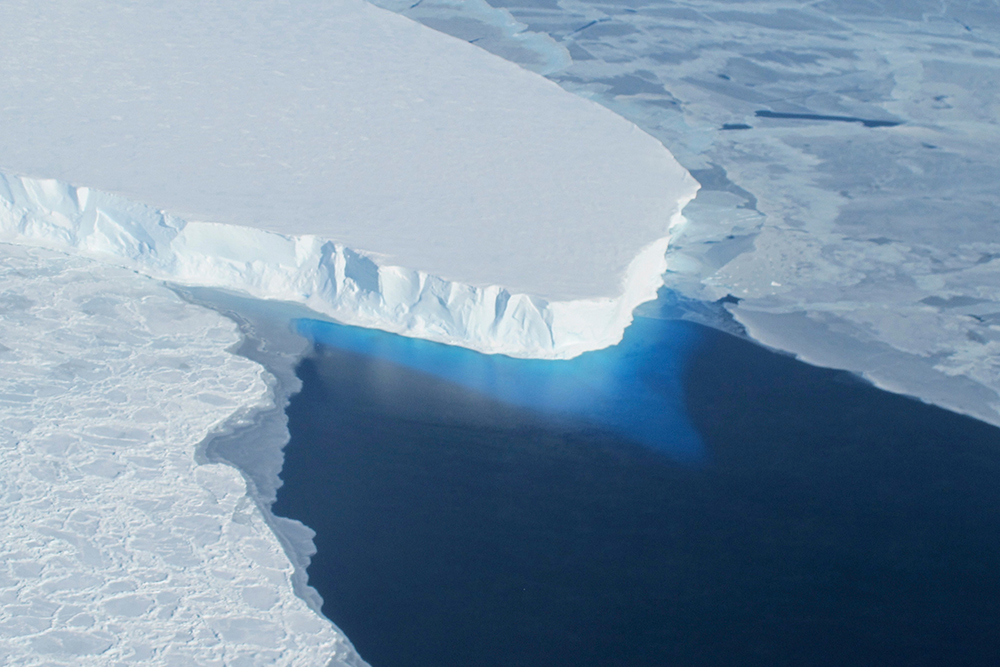
今年夏天,干旱、热浪和洪水已经成为全世界人们关注的焦点,但人们可能很容易忘记海平面上升带来的迫在眉睫的威胁。
然而,这种威胁实际上并没有那么遥远。多年来,科学家们一直在研究南极洲的一块特殊冰盖,该冰盖因为其巨大的体积和极快的融化速度而被称为“末日冰川”(doomsday glacier)。9月5日发表在学术期刊《自然·地球科学》(Nature Geoscience)上的一项新研究强调,它的融化速度可能比预期的还要快。
“末日冰川”的正式名称是思韦茨冰川(Thwaites Glacier),位于南极洲的西部边缘。思韦茨冰川融化已经造成全球海平面上升了约4%,每年有数十亿吨冰流入海洋。
思韦茨冰川完全融化可能导致海平面上升3英尺(91.44厘米)到10英尺(304.8厘米)。目前,水下山脊将其固定住,有助于阻止其消退。
去年,科学家们报告说,冰川有从该山脊脱离的危险。科学家们还观察到裂缝在整个冰盖蔓延,这引发了人们对冰川变得更加不稳定的担忧。
虽然多年来科学家们已经知道冰川正在迅速融化,但一直缺乏数据来说明其更广泛的地质历史。本周由南佛罗里达大学(University of South Florida)的海洋地球物理学家阿拉斯泰尔·格雷厄姆领导的研究,试图用从冰川水下足迹中提取的数据来填补这一空白,以展示它在几十年的时间跨度内是如何变化的。
通过分析数据,科学家团队发现,在过去的两个世纪里,思韦茨冰川可能经历了非常迅速的消退期——比如今的融化速度还要快。
那么,未来冰川有可能经历类似的快速变化期。海洋地球物理学家、该研究的合著者罗伯特·拉特在该研究发表随附的声明中表示:“思韦茨冰川如今岌岌可危,我们应该会在短时间内看到巨大变化——甚至从明年到下一年——一旦冰川消退到冰床上的浅山脊以外。”
根据联合国(United Nations)的数据,全球约40%的人口生活在距离海岸100公里以内的地区,海平面上升威胁着数百万人。南佛罗里达大学海洋科学学院(University of South Florida College of Marine Science)的院长汤姆·弗雷泽说:“不能因为思韦茨冰川不在我们的视线范围内,我们就忘记思韦茨冰川。这项研究在为全球规划工作提供必要信息方面迈出了重要的一步。”
根据联合国政府间气候变化专门委员会(Intergovernmental Panel On Climate Change)的数据,目前地球平均温度比19世纪末高1.1摄氏度(33.98华氏度),而且最早在未来十年,地球有可能变暖1.5摄氏度(34.7华氏度)。这些增量将对海平面上升产生巨大影响。
格雷厄姆在9月5日的新闻稿中警告说:“对思韦茨冰川的轻轻一击就可能引发巨大反应。”(财富中文网)
译者:中慧言-王芳
今年夏天,干旱、热浪和洪水已经成为全世界人们关注的焦点,但人们可能很容易忘记海平面上升带来的迫在眉睫的威胁。
然而,这种威胁实际上并没有那么遥远。多年来,科学家们一直在研究南极洲的一块特殊冰盖,该冰盖因为其巨大的体积和极快的融化速度而被称为“末日冰川”(doomsday glacier)。9月5日发表在学术期刊《自然·地球科学》(Nature Geoscience)上的一项新研究强调,它的融化速度可能比预期的还要快。
“末日冰川”的正式名称是思韦茨冰川(Thwaites Glacier),位于南极洲的西部边缘。思韦茨冰川融化已经造成全球海平面上升了约4%,每年有数十亿吨冰流入海洋。
思韦茨冰川完全融化可能导致海平面上升3英尺(91.44厘米)到10英尺(304.8厘米)。目前,水下山脊将其固定住,有助于阻止其消退。
去年,科学家们报告说,冰川有从该山脊脱离的危险。科学家们还观察到裂缝在整个冰盖蔓延,这引发了人们对冰川变得更加不稳定的担忧。
虽然多年来科学家们已经知道冰川正在迅速融化,但一直缺乏数据来说明其更广泛的地质历史。本周由南佛罗里达大学(University of South Florida)的海洋地球物理学家阿拉斯泰尔·格雷厄姆领导的研究,试图用从冰川水下足迹中提取的数据来填补这一空白,以展示它在几十年的时间跨度内是如何变化的。
通过分析数据,科学家团队发现,在过去的两个世纪里,思韦茨冰川可能经历了非常迅速的消退期——比如今的融化速度还要快。
那么,未来冰川有可能经历类似的快速变化期。海洋地球物理学家、该研究的合著者罗伯特·拉特在该研究发表随附的声明中表示:“思韦茨冰川如今岌岌可危,我们应该会在短时间内看到巨大变化——甚至从明年到下一年——一旦冰川消退到冰床上的浅山脊以外。”
根据联合国(United Nations)的数据,全球约40%的人口生活在距离海岸100公里以内的地区,海平面上升威胁着数百万人。南佛罗里达大学海洋科学学院(University of South Florida College of Marine Science)的院长汤姆·弗雷泽说:“不能因为思韦茨冰川不在我们的视线范围内,我们就忘记思韦茨冰川。这项研究在为全球规划工作提供必要信息方面迈出了重要的一步。”
根据联合国政府间气候变化专门委员会(Intergovernmental Panel On Climate Change)的数据,目前地球平均温度比19世纪末高1.1摄氏度(33.98华氏度),而且最早在未来十年,地球有可能变暖1.5摄氏度(34.7华氏度)。这些增量将对海平面上升产生巨大影响。
格雷厄姆在9月5日的新闻稿中警告说:“对思韦茨冰川的轻轻一击就可能引发巨大反应。”(财富中文网)
译者:中慧言-王芳
While droughts, heat waves, and flooding have taken center stage this summer for people around the world, it may be easy to forget about the looming threat posed by rising sea levels.
That threat, however, is not actually so far off. For years, scientists have studied one particular ice sheet in Antarctica nicknamed the “doomsday glacier” for its enormous size and rapid rate of melting. A new study published in the academic journal Nature Geoscience on September 5 highlights the possibility that it could break down even faster than expected.
The “doomsday glacier,” known formally as the Thwaites Glacier, sits along the western edge of Antarctica. It already contributes about 4% to global sea level rise, shedding billions of tons of ice into the ocean annually.
Its total loss could translate to anywhere from three to 10 feet of sea level rise. For now, an underwater ridge pins it in and helps to keep its retreat in check.
Last year, scientists reported that the glacier is at risk of detaching from that ridge. Cracks have also been observed spreading throughout the sheet, sparking concerns that the glacier is becoming more unstable.
While scientists have known for years that the glacier is melting rapidly, there’s been a lack of data to contextualize its broader geologic history. This week’s study, led by University of South Florida marine geophysicist Alastair Graham, seeks to fill in that gap by using data culled from the glacier’s underwater footprint to show how it has shifted over the span of many decades.
Analyzing the data, the team of scientists discovered that the Thwaites Glacier has likely experienced periods of very rapid retreat over the last two centuries—faster than the rate of melting today.
It’s possible, then, that the glacier could undergo similar periods of rapid change in the future. “Thwaites is really holding on today by its fingernails, and we should expect to see big changes over small timescales in the future—even from one year to the next—once the glacier retreats beyond a shallow ridge in its bed,” said marine geophysicist and study coauthor Robert Larter in a statement that accompanied the study’s publication.
With approximately 40% of the world’s population living within 100 kilometers of the coast, according to the United Nations, sea level rise threatens millions of people. “Just because it’s out of sight, we can’t have Thwaites out of mind,” said Tom Frazer, dean of the University of South Florida College of Marine Science. “This study is an important step forward in providing essential information to inform global planning efforts.”
On average, Earth is currently 1.1° C (33.98° F) warmer today than it was at the end of the 19th century, according to the Intergovernmental Panel on Climate Change, and is at risk of warming by 1.5° C (34.7° F) as early as the next decade. Those incremental increases will have enormous consequences for sea level rise.
“Just a small kick to Thwaites could lead to a big response,” warned Graham in September 5’s release.






